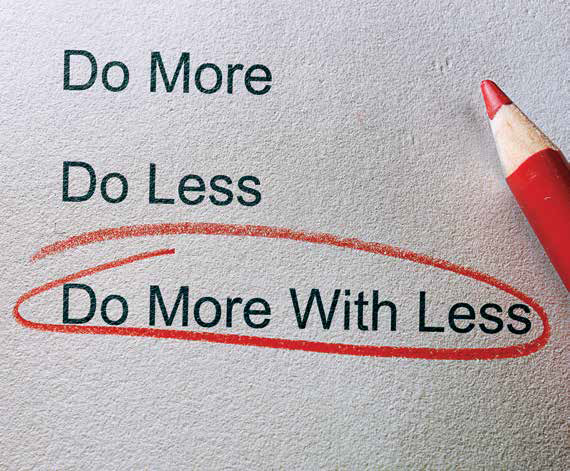
A few years ago, I wrote about a stale cliché that refuses to die, “We have to do more with less.” I cringe just thinking about it. I close my eyes and see a defeated-looking manager saying it to his or her staff while bemoaning budget cuts, barking about buckling down, and fretting about lean times ahead.
Since I wrote that piece, I feel like I have heard the phrase more than ever. So, for the new year, I am taking another stab at why this bothers me so much. And I want to offer an alternative way to think about achieving greater results with fewer inputs that can actually be valuable and energizing to a team.
A fool’s errand
“Do more with less” is classic negative thinking masquerading as a positive statement. It might sound like a bracing call for hard work, but it is essentially an invitation to beat your head repeatedly into a wall.
Unless you are running an inefficient organization, a big shift in circumstances — say, a budget cut or the loss of headcount — calls for more than just belt-tightening. It demands real changes to your operating model, changes that require courage, and an appetite for risk. This is because the only way to do more of anything in a sustainable way is to do less of something else. And the less side of that equation is, by necessity, something you are currently doing, probably something you are doing competently, and definitely something that will feel scary to abandon.
Why scary? Because it is hard to stop doing things that currently occupy your work. You developed a proficiency in something for a good reason: because that skill or task was needed at the time. Deciding to stop is intellectually and emotionally challenging. I have observed that even eliminating mundane, repetitive, or low-value tasks that a team is performing, whether via outsourcing or technology, is still a hard transition. It trades known and (once) valued outputs for the unknown and (so far) unvalued. It’s tempting to stick with what worked before and just run the machine harder. But it is necessary to avoid this trap.
When you are challenged to cut your spending and headcount in half (as I once was), the only way is to make big, fundamental changes. Working half of your resources twice as much in an attempt to achieve the same basic result will lead to failure and misery. As difficult as that kind of challenge is, it can be the start of a positive transformation, a springboard to take the team into a new and better state. But you must change both the inputs (resources) and the outputs (deliverables). To me, “doing more with less” accomplishes neither.
Redefine what matters and do that instead
Here is the reality: We live in an era defined by constant transformation. We see whole industries — really, entire economies — being disrupted and reinvented through digital transformation. And we see it at the individual and team level as well. The scale and pace of change in just about every part of the organization is simultaneously electrifying and dizzying.
Don’t be a prisoner to your previously successful methods. When global scale can be achieved online almost overnight, does a formerly winning strategy to build-out retail spaces really make sense today? If you continue trying to squeeze a little bit more out of an old, tired machine, the machine will eventually break. You have to be an inventor, a builder, an innovator. But inventing, building, and innovating are hard. How do we let go of familiar and comfortable routines? It’s a journey without a map to an elusive destination.
Avoiding the “more with less” trap requires looking at old problems in new ways. If you have to cut your budget and team in half, agonizing over which 50 percent to cut and which 50 percent to spare probably is not the right answer. Indeed, you may need to eliminate far more and reorganize your resources in an entirely new way.
When the answers aren’t easy, it’s hard to know where to look. For me, a deliberate change of perspective can unleash creativity and yield fresh solutions to stubborn challenges. Great ideas come in the shower for a reason. It’s no wonder that AI, design thinking, and biomimicry, among others — all of which we have explored on my team — are popular tools to help rewrite processes, redesign products, and reveal new insights and business models.
Sound a bit out there? Sure. But that line of thinking helped us come up with new ways to approach and perform most of the work on our team, and will be required for us to continue transforming to meet the rapidly changing demands of our customers, partners, and communities.
Competent managers will find a way to do a little bit more. Great managers will find a way to do it differently and to open up entirely new horizons of possibility.




